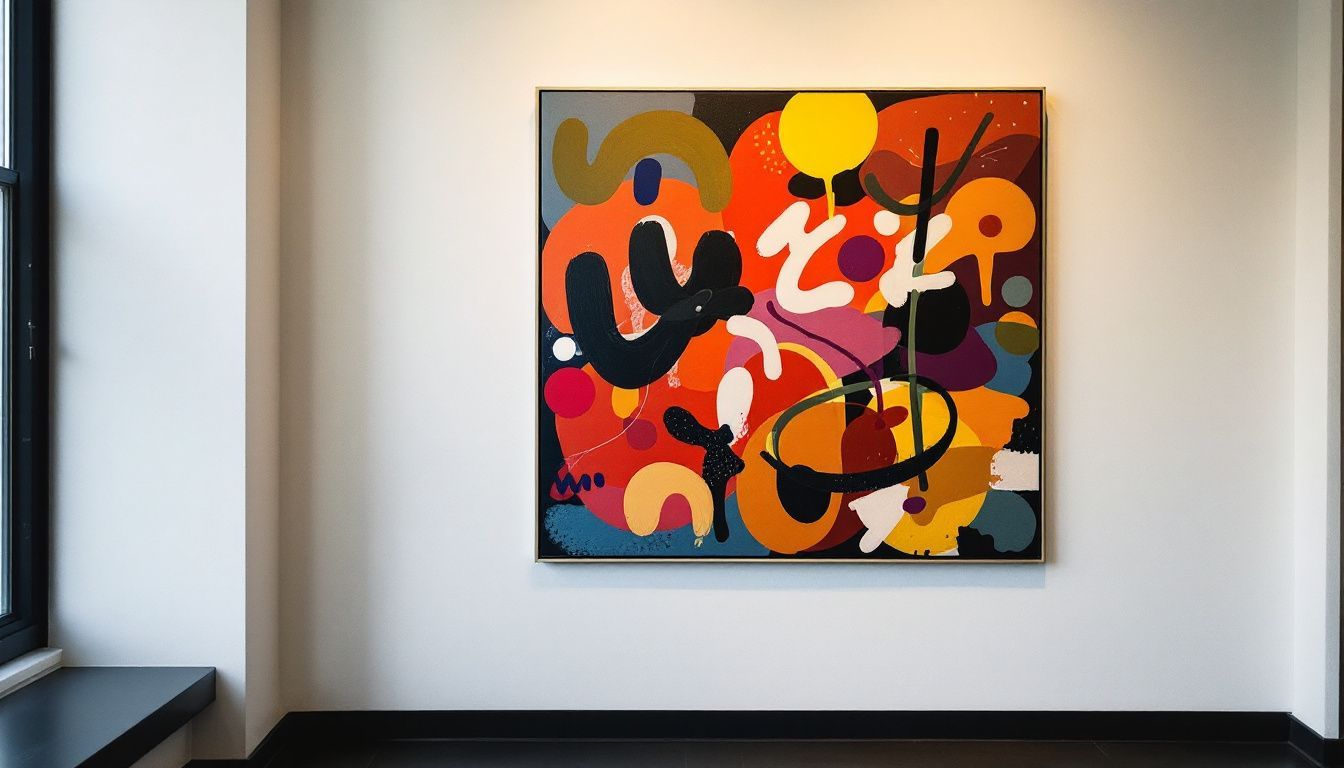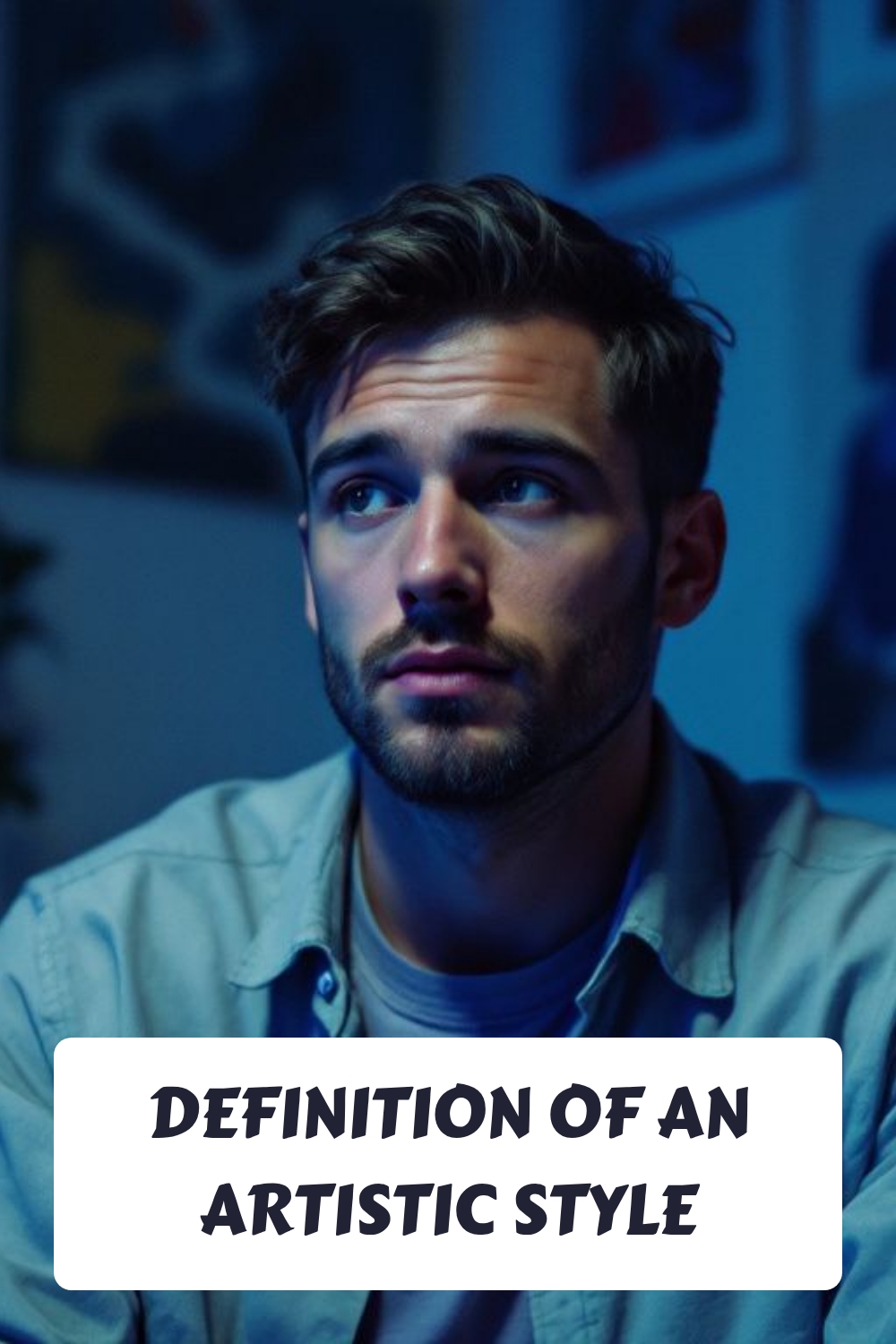HomeBlogsBlogsEntertainmentArtDefinition of an Artistic Style
Definition of an Artistic Style
Ever felt lost in a museum, staring at a painting and wondering what makes it special? Or perhaps, while flipping through an art book, you’ve struggled to understand why two pieces from the same time look so different.
You’re not alone. Many people find the wide world of art styles both fascinating and a bit confusing.
One key thing to know is that an artistic style is like an artist’s signature. It’s unique and shows how they view the world using colors, shapes, and lines. This article will help make sense of these styles—from abstract works by Jackson Pollock to impressionist landscapes by Claude Monet—and explain why they matter.
Get ready for a clearer picture!
Key Takeaways
- An artistic style shows how an artist sees the world using colors, shapes, and lines. It’s their unique way to express vision.
- Styles are different from art movements. Styles show an individual artist’s choices. Movements are trends shared by many artists at a time.
- Key parts of style include the use of form, color choices, and techniques. Each artist mixes these in their own way.
- History, personal experiences, and new technology all change artistic styles over time.
- To understand an artist’s style, look at details like brushwork and color use. Avoid mixing up styles with movements or missing the influence of culture.
Defining an Artistic Style
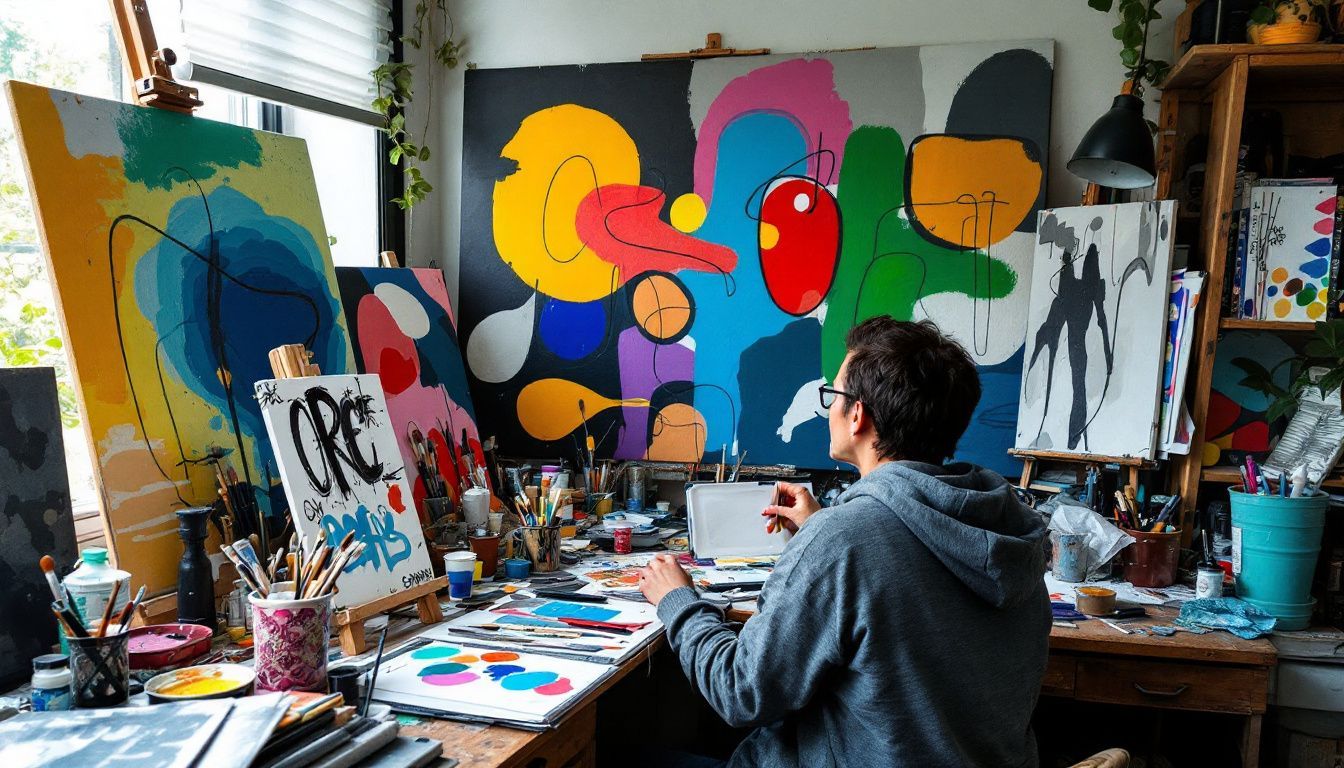
An artistic style is the distinctive manner in which an artist, group, period, or movement creates works of art. It encompasses the unique combination of techniques, methods, visual features, and expressive decisions that make an artist’s work recognizable and differentiates it from others. Style focuses on how an artwork is depicted rather than what is depicted, though subject matter can also contribute to overall style.
An artistic style may reflect personal identity, cultural influences, historical context, and technical choices, functioning as a kind of “visual signature” for an individual artist or artistic community. Thus an Artistic style is how an artist shows their view through their work. It includes things like colors, shapes, and lines that make one artist’s work different from another’s.
Core Factors That Make an Artistic Style
1. Visual Elements
The way an artist manipulates form, color, line, shape, texture, and space contributes significantly to their style:
-
Color palette: Choices of colors and their combinations create mood and emotional tone.
-
Brushwork and line: The application of paint or drawing technique, such as visible brushstrokes or smooth blends.
-
Composition: The arrangement of elements within the artwork, balance, and focal points.
2. Techniques and Processes
Distinctive methods or processes, such as oil painting, watercolor, digital media, collage, or sculpture, influence the final appearance of the work.
3. Subject Matter and Thematic Consistency
Recurring themes, motifs, or types of subjects (e.g., landscapes, portraits, abstraction) form part of a consistent artistic identity.
4. Expression and Personal Narrative
The emotions, narrative, and worldview the artist conveys. Often, style reflects authentic personal experience or point of view, adding a layer of meaning unique to the creator.
5. Cultural and Historical Context
Cultural background, era, and influences from social, political, or technological forces help define the broader framework of an artistic style, linking individuals to movements or traditions.
6. Philosophy or Artistic Intent
The underlying beliefs or artistic goals—what the artist is trying to express about the world or themself—also shape style. Some artists prioritize faithful representation, while others seek to abstract, exaggerate, or innovate
Table: Core Factors of an Artistic Style
| Factor | Description | Example |
|---|---|---|
| Visual elements | Use of color, line, form, space, texture, composition | Impressionist brushwork, minimalist lines |
| Techniques | Media and processes, such as oil, collage, digital | Watercolor washes, impasto painting |
| Subject matter | Common themes, motifs, or iconic subjects | Portraits by Rembrandt, landscapes by Monet |
| Expression | Emotions or personal stories embedded in the work | Kahlo’s symbolic personal motifs |
| Cultural context | Influences from artist’s heritage, historical period, or global trends | Japanese Ukiyo-e woodblock prints, Cubism in early 20th-century France |
| Artistic intent | Beliefs, philosophies, or ideals guiding artistic choices | Abstraction to express universal truths, realism for documentation |
Core Components of an Artistic Style in Art
Every artist has a unique way of showing their vision. This comes from the different parts that make up their style in art.
Here are the main 9 parts to comprise an Artistic Style:
-
Use of form
-
This is about the shapes, lines, and structure an artist chooses. Think of how Paul Cézanne painted Mont Sainte-Victoire with bold, defined strokes.
-
Color choices
- Artists pick colors to set a mood or show feelings. Mark Rothko, for example, used large blocks of color to touch people’s emotions deeply.
-
Composition
- This is how an artist arranges everything in their work. Look at “The Ecstasy of Saint Teresa” by Bernini where every part guides your eye through the story.
-
Texture and Materials
- What an artwork feels like, or seems it would feel like if you could touch it, adds a lot to its style. The roughness in Giorgio Vasari’s architectural works gives them character.
-
Technique
- How an artist applies paint or creates lines, whether smooth like in Renaissance art or more free and expressive as seen in Impressionism with artists like Edgar Degas.
-
Perspective and Space
- How depth and dimension are shown can really define a style. Early Renaissance pieces often explored these new ways of looking at space.
-
Influence from Art Movements
- Whether following the detailed nature of Neoclassicism or breaking rules with Cubism, movements shape individual styles.
-
Personal Experiences and Emotions
- Personal stories and feelings drive what an artist makes and how they make it. Expressionist artists used their work to show intense emotions directly.
-
Historical context and Technology Advances
- Times change and so do art styles, partly because new tools come along but also because society shifts what it likes or wants to talk about.
An artistic style emerges from a combination of visual elements, technical choices, recurring themes, and authentic expression, all shaped by personal, cultural, and historical influences. These core factors work together to create a recognizable “signature” that distinguishes one artist or movement from another and gives art its unique character. Understanding these parts helps us see why each piece of art feels different—even when two artists paint the same thing! Next up: exploring different types of artistic styles further explains this idea.
SHOP NOW ZAZZLE - CLICK BELOW
Does an artist’s emotional expression influence their Artistic style?
An artist’s emotional expression profoundly shapes their artistic style by influencing choices in color, form, technique, and subject matter, resulting in a body of work that uniquely reflects their inner feelings and personal experiences. Emotional states serve as a catalyst for creative decisions. Whether an artist seeks to convey joy, sadness, anger, love, or turmoil, these feelings are translated into visual elements that shape the artwork’s mood and impact.
Key ways emotional expression influences an artistic style include:
-
Color palette: Emotions dictate color choices—warm colors like reds and yellows often convey passion or energy, while cool blues and greens evoke calm or melancholy. Intense emotions might result in bolder, more vivid tones; subdued emotions might encourage muted palettes.
-
Brushwork and technique: Artists experiencing strong emotions may use vigorous, expressive brushstrokes for immediacy and intensity, while more tranquil states could favor softer, controlled marks. Techniques such as distortion or exaggeration (as in Expressionism) are frequently used to visually communicate emotional depth.
-
Composition and form: Emotional priorities may alter composition and form. For example, using dynamic, off-balance arrangements to suggest chaos or unease, or harmonious structures to reflect inner peace.
-
Symbolism and subject matter: Personal symbols, repeated motifs, or narrative elements tied to specific experiences or states of mind can dominate an artist’s style, making their emotional concerns visually recognizable.
Movements like Expressionism exemplify this connection, deliberately placing subjective emotions and internal states above objective reality, often distorting form and color to intensify feelings. In general, artists channel their emotions—whether immediate or deeply buried—into visual form, creating a style that functions as an authentic extension of their psyche. This emotional authenticity also helps the artwork resonate more powerfully with viewers, forging a psychological and empathetic connection between creator and audience.
Put simply, an artist’s emotional expression is not just a component but a driving force of an artistic style they are using. Making each body of work as unique as the emotions that inspire it
How an Artistic style becomes more emotionally resonant to a viewer
An artistic style or styles become more emotionally resonant to viewers because they effectively tap into universal human feelings through a combination of visual elements, cultural context, and individual psychological triggers. Key factors contributing to this resonance an artistic style include the use of color, form, texture, subject matter, and the artist’s personal expression.
-
Color palette: Colors have strong psychological associations—red might evoke passion or danger, while blue signals calm or melancholy. Artistic movements and individual works often harness color theory to trigger specific emotions. For example, van Gogh’s “Starry Night” uses swirling blues and vibrant yellows to convey wonder and melancholy, creating an emotional journey for viewers.
-
Technique and brushwork: The way paint is applied (e.g., bold, frantic strokes in Expressionism or Abstract Expressionism) directly conveys an artist’s emotional state and pulls the viewer into that experience. This physicality can make a piece feel more authentic and immediate.
-
Form and composition: The arrangement of visual elements—chaotic or harmonious, smooth or jagged—produces feelings ranging from anxiety to serenity. Abstract styles are notable for eliciting deep emotions without representational subject matter: viewers project their own feelings onto color fields or shapes, making the experience highly personal.
-
Subject matter and symbolism: Iconic figures, scenes, or motifs may trigger powerful cultural or personal associations, while abstract art allows for open-ended interpretations, deeply engaging individual memory and experience.
-
Cultural and historical context: Styles emerging from periods of upheaval or innovation (like Expressionism during wartime) often mirror the collective psyche, making them resonant for those living through or reflecting on those times.
-
Artist’s intent and authenticity: When artists channel genuine emotion—stemming from personal joy, trauma, or existential questioning—the resulting works often communicate at a level that feels “real” and relatable, even across generations and cultures.
-
Viewer’s individuality: Emotional resonance isn’t fixed; a style or work’s impact depends on the viewer’s background, mood, and personal experiences. Abstract art, in particular, invites each person to find their own meaning, making it potentially resonant in unique ways for each observer.
In essence, emotionally resonant styles excel because they utilize universally understood visual “languages” and emotional cues, while also allowing for individual interpretation and deep personal connection—just as a powerful song or film from the Woodstock era or the peak of the box office can unite a generation but also speak to each person differently.
Style vs. Art Movement: Understanding the Differences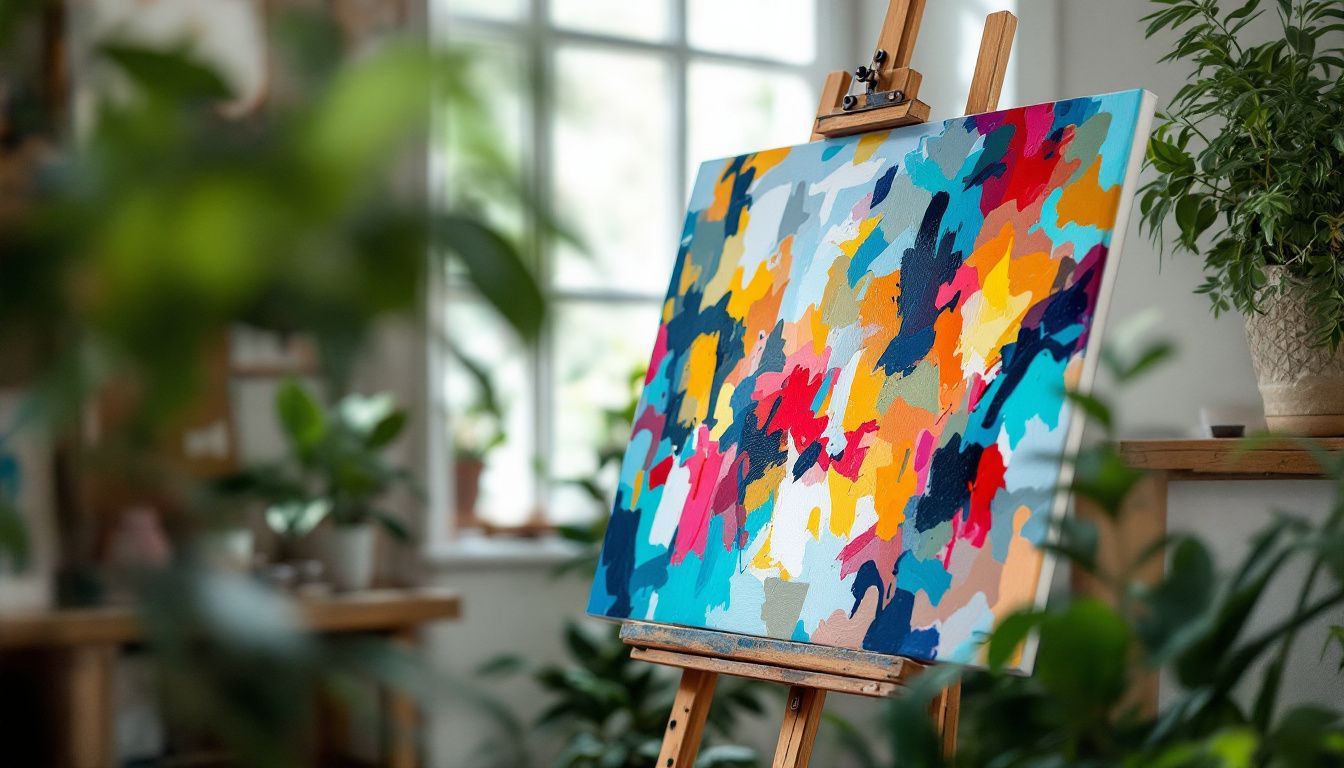
Style in art is how an artist shows their work. It’s their unique way to use shapes, colors, and lines. This could be the rough brushstrokes of Vincent van Gogh or the detailed dots in Georges Seurat’s pointillism.
An art movement, on the other hand, is a trend. It involves many artists during a certain time who share ideas and methods. Think of the Impressionist movement that included artists like Claude Monet and Edgar Degas.
Understanding these differences helps us see art better. For example, two paintings might look alike because they both use bright colors and loose brushwork. Yet one could be from an impressionist artist while the other follows no specific movement but has a similar style due to personal choice or influence from various sources including pop culture or African art.
On top of this, historical events often shape movements. The Surrealists were influenced by World War I’s aftermath unlike any single artist’s style which may evolve over time through personal growth or new technology such as text-to-image AI software used today by some creators.
So while styles can cross over different periods and cultures reflecting an individual’s approach with techniques such as abstraction or hyperrealism; movements are more about shared goals within a community at a given time like Baroque or Cubism that showcase collective characteristics acknowledging cultural shifts such as political changes or technological advances within period styles.
An Artistic Style can come in many Types
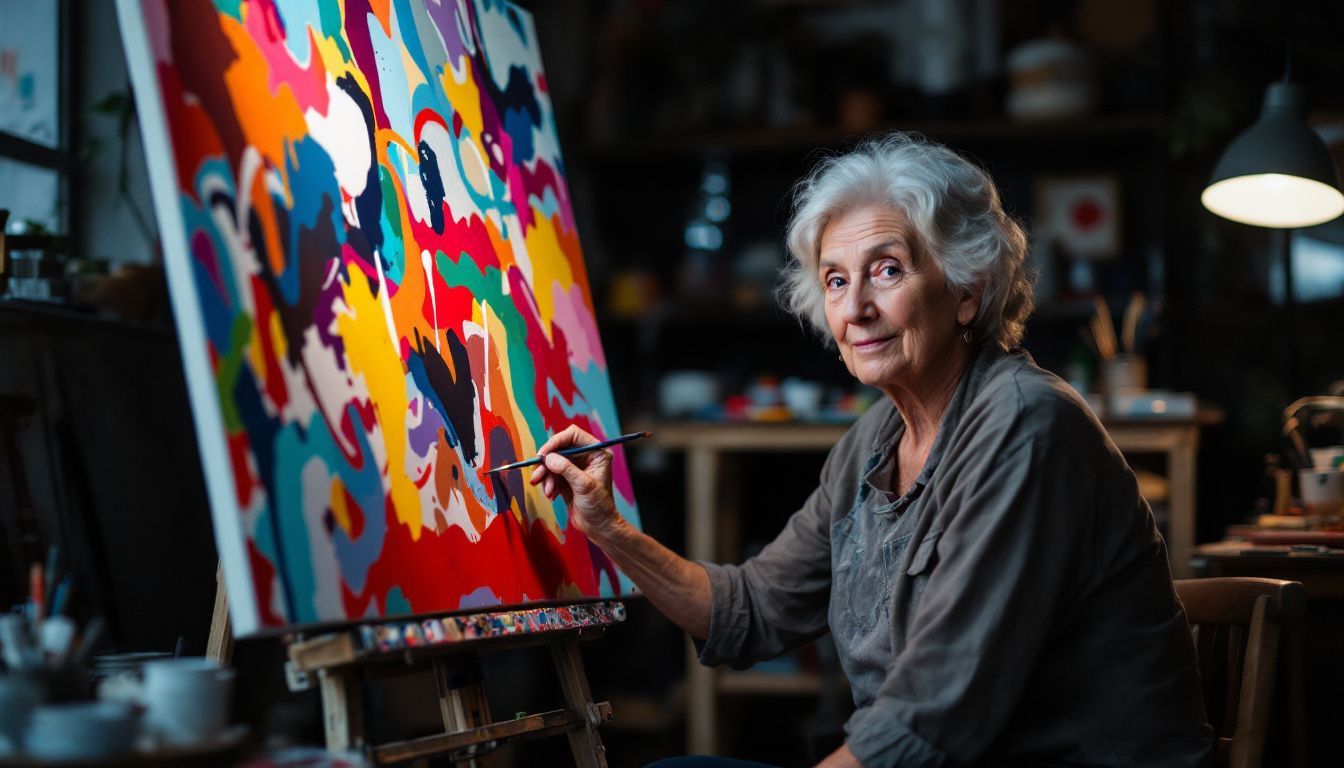
Art has many faces, from the lifelike images of realism to the bold strokes of expressionism. An artistic style can open a door to a new way of seeing and feeling the world around us.
Realistic
The realistic artistic style, known as Realism, is characterized by the accurate, detailed, and unembellished depiction of nature or contemporary life, aiming to represent subjects truthfully without artificiality, idealization, or exaggeration. Realism emerged as a significant movement in mid-19th century Europe, especially France, as a reaction against the stylized forms and dramatic, idealized art of Romanticism and Neoclassicism.
Realistic art shows things just like they are in real life. Artists who make realistic art pay a lot of attention to details. They want to capture every part of what they see. This means they look at how light and shadows work, the colors of objects, and even the textures.
They use these observations to create paintings or sculptures that look very close to real life.
Key features of the realistic style include:
-
Depiction of ordinary people and everyday scenes, often focusing on the lives of the working and middle classes, rather than historic, mythological, or heroic figures.
-
Emphasis on detail and accuracy to create works that closely resemble how subjects appear in reality.
-
Unflinching portrayal of life, including its mundane or even “ugly” elements, as Realist artists sought to confront rather than gloss over the truths of social existence.
-
Use of naturalistic techniques, such as careful attention to light, color, and perspective, to enhance the sense of authenticity.
Prominent artists associated with Realism include Gustave Courbet, Jean-François Millet, Honoré Daumier, and Jean-Baptiste-Camille Corot. Realist painting expanded what was considered an acceptable subject for fine art by elevating everyday events and people to the level of traditional “high” art
Differences Between Realism, Photorealism, and Hyperrealism
Understanding the distinctions among an artistic style like realistic (Realism), or photorealism, and hyperrealism offers insight into the evolution of art styles that aim to depict the world with increasing levels of fidelity and technical prowess.
Realism (Realistic Artistic Style)
-
Goal: Depict subjects truthfully and accurately, as they appear in everyday life, without idealization or exaggeration.
-
Typical Characteristics:
-
Focuses on ordinary people, scenes, and objects.
-
Uses naturalistic techniques—attention to light, color, and perspective.
-
The artwork is clearly made by an artist, even if it’s highly detailed; the “hand” of the creator is always present.
-
May employ various media like painting, drawing, or sculpture—think of it as “representational art.”
-
-
Effect: Viewers recognize it as art, not as a photograph.
Photorealism
-
Goal: Achieve an illusion so convincing that the artwork looks indistinguishable from a high-resolution photograph.
-
Typical Characteristics:
-
The artist faithfully replicates a photograph, capturing every detail, shadow, texture, and reflection.
-
Paintings often require extensive technical skill and attention to precision.
-
The subject matter is often mundane or ordinary, portrayed with a “deadpan,” objective tone—emotion and interpretation by the artist are minimized.
-
Uses reference photographs as the foundation.
-
-
Effect: When well-executed, it can be challenging for viewers to distinguish between a photo and a photorealistic painting.
Hyperrealism
-
Goal: Go beyond photorealism by creating works not just technically precise but also emotionally evocative, often with an even higher degree of clarity and detail.
-
Typical Characteristics:
-
Surfaces are more textured and expressive; colors can be more vivid and intense than the source photo.
-
Incorporates narrative, atmosphere, or psychological intent—artists may add extra layers of meaning, fantasy, or heightened reality.
-
Hyperrealism sometimes ventures into sculpture, making life-like three-dimensional representations.
-
The illusion can “transcend” reality by making scenes appear sharper, clearer, or more intriguing than real life itself.
-
-
Effect: Hyperrealism evokes a sense of awe, often feeling “more real than real,” drawing viewers into a heightened experience of reality.
Comparative Overview
| Aspect | Realism | Photorealism | Hyperrealism |
|---|---|---|---|
| Reference | Direct observation/nature | Photograph | Photograph, but often enhanced or manipulated |
| Artistic Intent | Faithful representation | Clinical replication, minimal emotion | Adds narrative, emotional and psychological depth |
| Level of Detail | High, but visibly handmade | Extreme, mimics photo exactly | Extreme, with heightened textures and clarity |
| Emotional Content | Present, but subtle | Typically detached or neutral | Strong, with added narrative or emotional context |
| Media | Traditional forms (painting, etc.) | Painting, drawing | Painting, sculpture, mixed media |
| Viewer Effect | Recognizable as art | May be mistaken for a photograph | More intense, “heightened” sense of reality |
In Summary
-
Realism: Accurate, believable, hand-rendered art that looks real but is still recognized as art.
-
Photorealism: Art that aims to be visually indistinguishable from a photograph, using the photo as the direct source.
-
Hyperrealism: Builds upon photorealism, offering not just technical perfection but also emotional and narrative impact, often creating a reality that surpasses the photographic reference
Art is not what you see, but what you make others see. – Edgar Degas
A good example of realistic art is a still life painting. These paintings show objects like fruits, flowers, or dishes in a way that makes them seem touchable. Realistic artists from history include people like Leonardo da Vinci and Johannes Vermeer.
They showed amazing skill in making their subjects look alive. Today, some artists use cameras and computers to help with their work. But the goal remains the same: making art that looks as close to real life as possible.
Art: Breaking from Reality
What Is Abstract Art?
Abstract art is an artistic style of art that fundamentally departs from representing physical reality. Rather than striving for accurate depictions of objects, people, or scenes, abstract artists use shapes, colors, lines, forms, and gestural marks to express ideas, emotions, and concepts. The result can range from slightly altered subjects (partial abstraction) to works that bear no recognizable reference to the real world (total abstraction).
How Abstract Art Breaks from Reality
-
Non-Representational Approach: Unlike realistic styles, abstract art is non-objective or non-representational. It does not aim to portray real-life appearances but instead focuses on creating new visual languages that exist independently of external reality.
-
Simplification and Distortion: When abstract art is based on recognizable subjects, those subjects are often simplified, schematized, or distorted, moving away from their natural appearance to emphasize certain qualities or feelings.
-
Freedom of Expression: Abstract art liberates artists from traditional rules. Instead of copying nature, the artist prioritizes emotion, composition, and experimentation, finding balance, discord, or rhythm through visuals rather than narrative or representational accuracy.
-
Personal Interpretation: Without a clear subject, the meaning of abstract art becomes subjective. Viewers interpret the compositions based on their personal feelings, experiences, and imaginations, often connecting with the work on an emotional rather than a literal level.
-
Visual Language: Abstract art often emphasizes pure artistic elements—such as color, form, and texture—over storytelling or figurative accuracy. This allows artists to explore spiritual, conceptual, or purely aesthetic concerns outside of reality’s constraints.
Abstract art as an artistic style breaks from reality. It does not show things as they are seen by our eyes. Artists in this style focus on colors, shapes, and textures instead of people or landscapes.
They use a mix of techniques to express feelings or ideas. Abstract art can look very different depending on the artist’s choices.
This kind of art came into being over a century ago. It has roots in earlier movements like Impressionism and Expressionism. These movements also played with color and form but still showed the real world.
Abstract artists went further, creating works that didn’t represent anything recognizable. Some famous abstract painters include action painters and color field painters from the New York School.
Art lovers enjoy abstract art because it makes them think and feel without showing something specific. Each viewer might see something different in an abstract painting or sculpture because it speaks to emotions and personal experiences more than exact images.
Continuum of Abstraction
Abstraction exists on a spectrum:
| Style | Relation to Reality | Example Characteristics |
|---|---|---|
| Realism | Direct representation | Faithful depiction of visible world |
| Partial Abstraction | Modified reference to reality | Colors, shapes, or forms altered, but some elements recognizable |
| Total Abstraction | No reference to reality | Pure shapes, colors, lines, no recognizable subject |
Impressionist
Impressionist artists changed art. They painted light and its changing qualities instead of clear, sharp details. This style shows scenes from daily life. Artists like Claude Monet and Edgar Degas are famous for this.
They used quick brush strokes to capture moments. Their work looked different depending on the time of day due to the sunlight.
This movement started in France during the late 19th century. It was a break from traditional art forms that focused on historical and religious themes. Impressionists found beauty in ordinary things.
They often worked outside to catch natural light’s true colors and shadows.
They also liked showing how cities and landscapes looked during different times of year or day, bringing a new focus to modern life’s speed and changes. Their techniques led to other styles like abstract and expressionism, making a big impact on art history.
Impressionist artists are defined by their innovative approach to capturing immediate visual impressions of the world, particularly focusing on the fleeting effects of light and atmosphere rather than detailed, realistic representation.
Core characteristics of the Impressionist style:
-
Visible, loose brushstrokes: Impressionists used small, broken, or rapid brushstrokes, leaving paint unmixed and visible to capture the feeling or impression of a scene rather than its fine details.
-
Focus on light and its changing qualities: Paintings emphasized the effects of natural light, often portraying scenes at different times of day to show how light altered color and form.
-
En plein air (outdoor) painting: Impressionists painted outdoors to directly observe and render the effects of light and atmosphere, rather than working solely in studios.
-
Ordinary, contemporary subjects: They depicted modern life, landscapes, urban scenes, and everyday people, moving away from historical, religious, or mythological themes.
-
Unblended, vibrant color: Pure, intense colors were placed side by side with minimal blending, allowing the viewer’s eye to mix them and enhancing the sense of spontaneity and brightness in the work.
-
Open composition: Compositions often featured cropped, informal views and unusual visual angles, reflecting the influence of photography and Japanese art.
-
Capturing the moment: The goal was to convey a fleeting “impression”—the sensory experience of a specific moment—rather than a detailed, timeless portrayal.
Notable Impressionist artists include Claude Monet, Pierre-Auguste Renoir, Camille Pissarro, Edgar Degas, Alfred Sisley, Berthe Morisot, and Mary Cassatt.
These stylistic choices were initially seen as radical, even unfinished, but they fundamentally transformed modern art by prioritizing the sensory and experiential over traditional notions of realism.
Expressionist
Transitioning from the focus on illumination and hues in Impressionist art, we step into the arena of Expressionism. This genre plunges intensely into emotions and personal experiences.
Artists within this movement go beyond merely illustrating what something appears like. They expose their sentiments towards it.
Expressionist artists apply vibrant colors and firm lines. They distort reality to manifest their internal emotions. It isn’t about replicating an accurate representation but rather depicting what it signifies to the artist on an emotional level.
Abstract expressionists extend this concept by utilizing shapes and colors in a manner that may not resemble anything recognizable but still communicates intense feelings.
So what defines Expressionist art?
Expressionist art is defined by its focus on expressing the artist’s subjective emotions, inner experiences, and psychological states rather than accurately depicting objective reality. This style intentionally distorts and exaggerates forms, colors, and compositions to evoke intense feelings and communicate the artist’s inner vision or emotional response to the world.
Key characteristics of Expressionist art include:
-
Distorted or exaggerated lines and shapes: Artists alter figures, landscapes, and objects, often making them appear unnaturally twisted or contorted, to emphasize emotional effect rather than visual accuracy.
-
Intense, non-naturalistic color: Colors are chosen for their emotional associations rather than realistic representation. They may be vivid, sometimes dark, and often serve to heighten the dramatic or moody atmosphere of the work.
-
Bold, raw brushwork and thick paint application: Brushstrokes are visible, energetic, and sometimes aggressive, giving the surface of the painting a dynamic, visceral quality.
-
Subjectivity and personal vision: The artwork reflects the artist’s inner world, exploring themes like alienation, anguish, spiritual crisis, and existential angst.
-
Rejection of realism: Expressionism arose partly as a reaction against Realism and Impressionism, prioritizing feeling over faithful representation of the external world.
Expressionism originated primarily in Germany in the early 20th century with influential groups like Die Brücke (The Bridge) and Der Blaue Reiter (The Blue Rider). Notable artists in this movement include Edvard Munch, Ernst Ludwig Kirchner, Wassily Kandinsky, Egon Schiele, and Franz Marc.
Art is not what you see, but what you make others see. – This statement is profoundly harmonious with Expressionism, where artists strive to generate the same feelings in viewers that they themselves experienced.
Factors Influencing the Artist and an Artistic Style

What shapes an artistic style of an artist? Think of it as a mix of the time they live in, their own life stories, and the new tools they use to create. Whether it’s painting with brushes or using modern image-making software, every tool and experience adds a unique touch.
Keep reading to explore more about how these elements come together to define artistic expression.
Historical Context
Art styles aren’t simply birthed from thin air. They evolve from historical contexts, influenced by societal shifts and events. Ponder on the Renaissance period, an epoch abundant with fresh notions and perspectives on the world.
Acclaimed artists such as Leonardo da Vinci began to employ techniques that portrayed people and nature with more authenticity. This shift occurred gradually, representing broader changes in how individuals perceived their self identity and their position in the cosmos.
The Industrial Revolution serves as yet another instance. It transformed more than just manufacturing methods, it also altered the nature of art. The advent of modern technology provided artists with an array of new tools—such as portable paint tubes, enabling them to depict landscapes directly in the open air.
This era birthed Impressionism, where artists like Claude Monet depicted fleeting instances, brimming with light and color, in stark contrast to the precise historical scenes or portraits that most were accustomed to.
Each historical period imprints its essence on art, stimulating artists to delve into innovative concepts and techniques. Ranging from the order and harmony of classical art to the vibrant emotional expressions of abstract expressionism, it is clear – time molds style.
Personal Experiences
Artists bring their own histories to the canvas. Each brush stroke carries bits of their joys, struggles, and journeys. Think of Paul Cezanne. His work shows how an artist’s life influences his style.
Cezanne’s landscapes don’t just show us nature; they reveal his deep connection to it.
Life events shape artists’ choices too. The bright colors in pop art? They mirror the bold culture of the 1960s. Personal experiences guide artists in picking themes, colors, and shapes.
This makes every artwork a piece of the artist’s story.
These stories change with new technology as well. Tools like text-to-image AI art software let artists express in ways once impossible. Next up, we’ll see how technological advances add more layers to artistic styles.
Technological Advances
New tools and methods have changed how artists create their work. Digital tablets and software let them draw, paint, and design in ways not possible before. This tech also helps in sharing art with the world faster.
Art styles evolve as these new options become available.
Technology is shaping the future of artistic expression.
Now, people study art in new ways too. They use digital archives to look at old paintings from home. Let’s move on to exploring how we identify an artist’s style.
Identifying an Artistic Style

Figuring out an artist’s style is like solving a puzzle. You look at the pieces — their technique, the colors they choose, and even what their work feels like. Then, you start to see patterns that fit together in unique ways.
Tools like art analysis help with this task. They let you break down a painting or sculpture into parts to understand it better. This way, spotting differences between styles becomes easier, whether you’re looking at a detailed Renaissance piece or a bold pop culture canvas.
Techniques for Analyzing Style
Analyzing artistic style lets you understand the unique signature of an artist or art period. This process involves looking at the artwork’s visual elements and how they come together.
- Study the use of color – See how artists choose and mix colors to create mood or focus.
- Look at form and composition – Notice the shapes, lines, and how things are arranged in space.
- Consider texture and brushwork – Different strokes can suggest movement or add depth.
- Explore themes and subjects – What stories or ideas is the artist showing us?
- Examine historical context – Time periods often shape art styles in big ways.
- Gather insights from art historians – People like Giovanni Morelli help us see patterns in techniques across works.
- Spot differences in architectural styles – Buildings can also show style through design choices.
- Identify technological advances – New tools can change how artists work, leading to new styles.
- Pay attention to cultural influences – Locations and traditions can affect an artist’s style.
- Compare with other artworks – Putting pieces side by side makes it easier to spot unique traits.
Using these steps helps us grasp what makes each piece of art special. Whether we’re looking at a realistic portrait or an abstract sculpture, understanding style deepens our appreciation of art’s diversity.
Common Pitfalls in Style Identification
Moving from understanding how to analyze artistic style, let’s shift focus to common mistakes people make during this process. Identifying the style of art can be tricky. People often mix up styles or overlook important details.
- Mixing up historical art movements with personal styles. Some think a painting’s time period decides its style. This isn’t true. Artists can have personal styles that don’t match their era’s popular movement.
- Overlooking an artist’s technique. It’s easy to forget looking at brushwork, use of color, and other techniques that define a style.
- Ignoring the influence of culture and geography on style. For example, not seeing how Japonism impacted impressionist artists like Monet.
- Assuming all work by an artist fits one style. Artists like Picasso went through different phases, such as his Blue Period and Cubist Phase.
- Confusing stylization with stylised art forms in non-representational pieces. Some might not recognize the differences between deliberate abstraction and stylized representations of reality.
- Failing to consider technological advances that impact style. Photography changed how artists approached realism in their paintings.
- Not paying attention to detail in ornamentation and pattern contributes to interpreting a piece incorrectly – items reflecting the Arabesque or Rococo patterns might get misclassified if these elements are overlooked.
- Letting popular opinions shape your view too much—a work considered surrealism by many could actually more closely align with expressionism when analyzed without bias.
9 .Ignoring the context and story behind the artwork can lead to misunderstanding the intended expression or message of an artist—knowing why van Gogh painted “Wheat Field with Crows” adds depth to its stylistic analysis.
10 . Forgetting about iconography which is key in identifying religious or historical subjects’ styles such as those seen in “The Ecstasy of Saint Teresa” could lead one astray from recognizing its Baroque roots.
Each point highlights common pitfalls that can lead to incorrect identification of an art piece’s style, stressing the importance of a careful and informed approach during analysis.
Conclusion
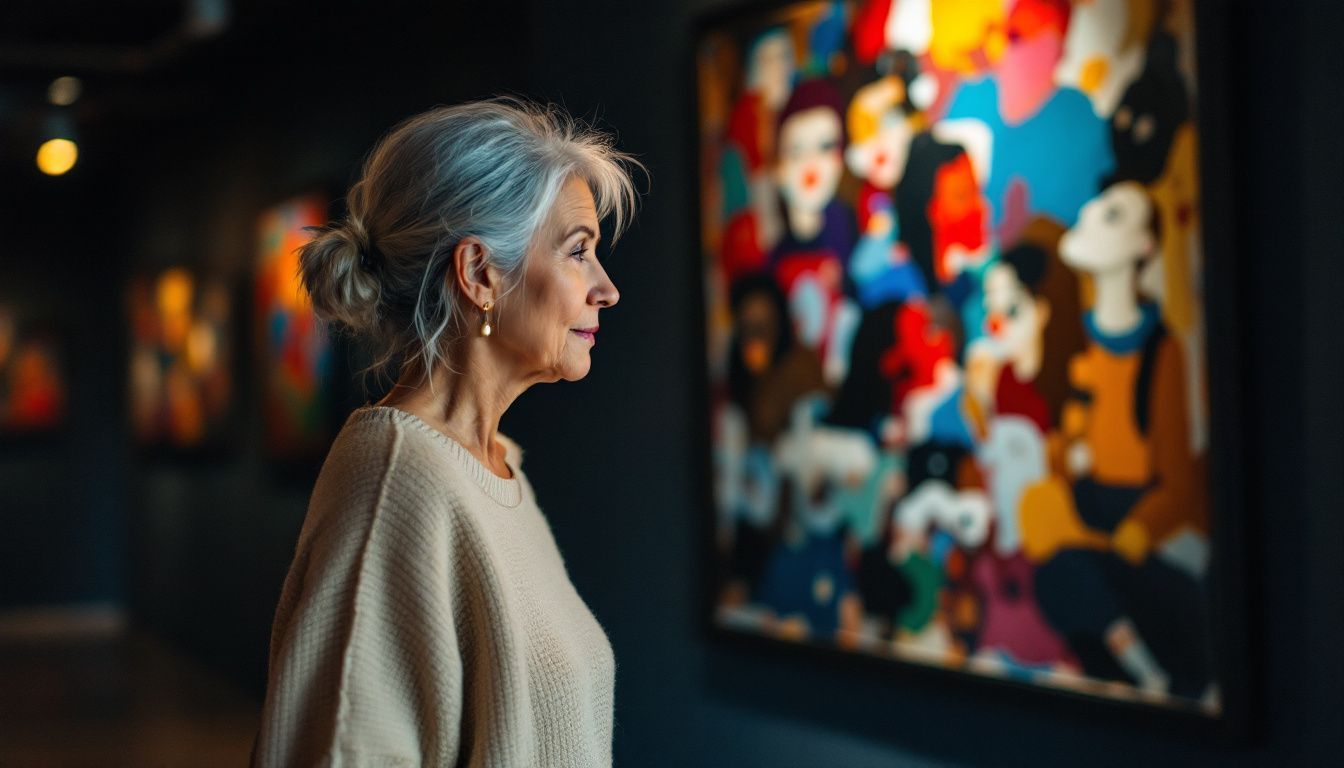
An artistic style is the way artists show their unique view of the world. It’s about the colors, shapes, and marks they make. Think of it as their signature. Styles change over time with new ideas and tools.
Artists also learn from their lives and history. This all mixes to create something special on canvas or clay.
An artistic style help us group art by look or time period. They also show what was important in culture then. Every artist has a style that grows as they do.
You can spot an artist’s style by looking close at how they use lines or color. But don’t get tricked into thinking one detail tells you everything.
Why not try this out? Look at some art and see if you can tell its style. You may notice more than before.
We shared ways to understand and find an artist’s style. Now it’s your turn to explore this in paintings, pots, or buildings around you.
FAQs
1. What does an artistic style mean in the history of art?
An artistic style refers to the unique way an artist or a group of artists, like those during the Mannerist period or Pop Art movement, use their medium to express their ideas. It involves specific techniques and stylisation that become associated with them.
2. How can we identify different artistic styles?
Typologies and seriation are two key methods used in archaeology and art history for identifying different styles. For example, by examining artefacts such as pottery or ceramics from Chinese art, one can categorize them based on shared characteristics.
3. Can you give examples of famous works representing distinct artistic styles?
Sure! The Ecstasy of Saint Teresa is a classic example from the Mannerist period while Death of the Virgin reflects mannerism – both depict religious scenes with multiple perspectives and exaggerated poses. On the other hand, pop artists embraced popular culture elements in non-representational ways; think Andy Warhol’s Marilyn Monroe portraits.
4. Are there any common misconceptions about defining an artistic style?
Yes indeed – it’s often thought that an artist’s style remains static throughout their career… but this isn’t true! Artists often evolve their approach over time – Giotto is renowned for his dramatic shift towards naturalistic depiction in portraiture and architecture.
5 Why do some people consider ‘style’ a controversial term within visual arts discourse?
The controversy lies mainly around its interpretation… Some argue that it limits understanding by focusing only on aesthetics rather than considering broader cultural contexts… Alois Riegl’s Stilfragen (Problems of Style) explores these debates extensively…
6 What role does setting play in shaping an artist’s style?
Setting plays a significant role – take Auvers-sur-Oise for instance where Van Gogh painted his final works… The environment influences how artists interpret what they see… Leon Battista Alberti emphasized this point in his Lectures on the Philosophy of History, noting that style reflects an artist’s interaction with their surroundings…


 Cart is empty
Cart is empty 







